Eryphanis automedon
| Eryphanis automedon | |
|---|---|
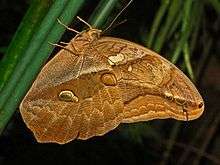 | |
| Scientific classification | |
| Kingdom: | Animalia |
| Phylum: | Arthropoda |
| Class: | Insecta |
| Order: | Lepidoptera |
| Family: | Nymphalidae |
| Genus: | Eryphanis |
| Species: | E. automedon |
| Binomial name | |
| Eryphanis automedon (Cramer, 1775) | |
| Synonyms | |
| |
Eryphanis automedon, the Automedon giant owl, is a species of butterfly belonging to the Nymphalidae family.
Description
Eryphanis automedon has a wingspan reaching about 55–60 millimetres (2.2–2.4 in). In males the dorsal sides of the wings show night blue iridescent patches, extending from submedial to postmedial areas, with well defined borders separating the non-iridescent sections. Ventral sides vary from faded brown to caramel color, with various eyespots. The female wingspan is slightly larger, with a slightly different wing color pattern.
This butterfly can live up to six weeks and flies in the dark forests of Latin America. It is a fast flying butterfly. The caterpillars are cryptically colored and feed at night on Poaceae host plants (mainly bamboo leaves), of which the elongated chrysalis mimics the appearance of a dried leaf.
Distribution
This butterfly is native to South America. It is present from Venezuela to the Guianas and Brazil and from Colombia to Paraguay, at an elevation of 0–1,000 metres (0–3,281 ft) above sea level.
Subspecies
The following subspecies are recognized:[1]
- Eryphanis automedon automedon (Suriname)
- Eryphanis automedon lycomedon (C. & R. Felder, 1862) (Guatemala and Costa Rica to Colombia)
- Eryphanis automedon amphimedon (C. & R. Felder, 1867) (Brazil)
- Eryphanis automedon tristis Staudinger, 1887 (Peru)
- Eryphanis automedon novicia Stichel, 1904 (Ecuador)
- Eryphanis automedon cheiremon Fruhstorfer, 1912 (Bolivia)
- Eryphanis automedon spintharus Fruhstorfer, 1912 (Colombia)
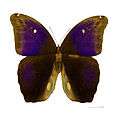 Eryphanis automedon automedon, male dorsal side - MHNT
Eryphanis automedon automedon, male dorsal side - MHNT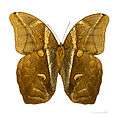 Eryphanis automedon automedon, male ventral side - MHNT
Eryphanis automedon automedon, male ventral side - MHNT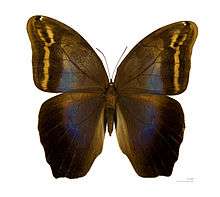 Eryphanis automedon automedon, female dorsal side - MHNT
Eryphanis automedon automedon, female dorsal side - MHNT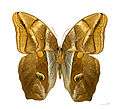 Eryphanis automedon automedon, female ventral side - MHNT
Eryphanis automedon automedon, female ventral side - MHNT
References
| Wikispecies has information related to: Eryphanis automedon |
| Wikimedia Commons has media related to Eryphanis automedon. |
- ↑ "Eryphanis Boisduval, 1870" at Markku Savela's Lepidoptera and Some Other Life Forms
- Carla M. Penz - Phylogenetic Revision of Eryphanis Boisduval, with a Description of a New Species from Ecuador (Lepidoptera, Nymphalidae) - Insecta Mundi, 2008
- BioLib.cz
- Tree of Life
- Catalogue of Life
- Natural History Museum